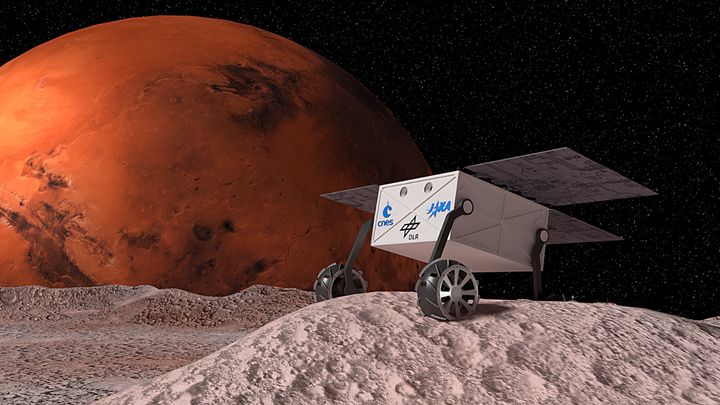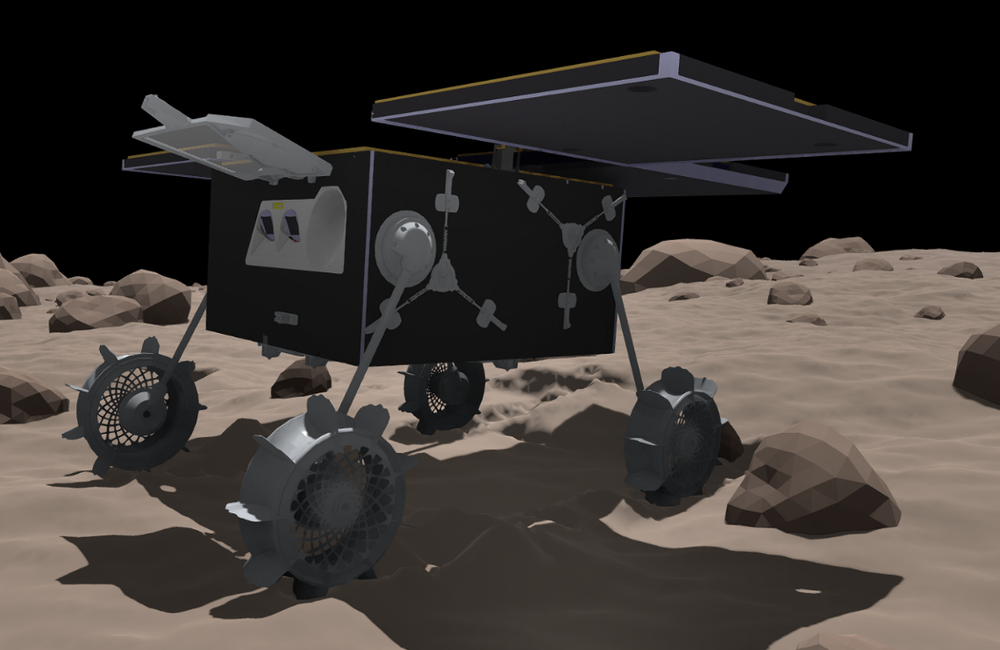MMX Mission: A rover for the Martian moon Phobos
How the moons were formed and what they are made of - this is the mystery that the international team of scientists wants to solve. Several US explorations and European missions - Mars Express (launched in 2003) and ExoMars Gas Trace Orbiter (launched in 2016) - have already provided data and images from Mars orbit, which have been used to observe the moons. There has not yet been a successful landing on one of them. Little is therefore known about their geological, mineralogical and geochemical properties.
The MMX space probe from the Japanese space organisation JAXA is set to change this: it will examine the two Martian moons in detail from orbit and collect material samples from Phobos for the first time. It will also carry the MMX rover from DLR and CNES and set it down on Phobos. The ambitious project is expected to start in 2026.
European part of the mission: the MMX rover IDEFIX
The MMX landing vehicle will fulfil several tasks on Phobos: Firstly, it will provide important findings in preparation for the landing of the mother ship. Secondly, it will analyse the surface composition and properties at interesting locations.
Eight DLR institutes from five locations are contributing to the rover: The Institute of Robotics and Mechatronics is in charge of overall project management and - together with the Institute of Space Systems - of system engineering. In addition, the Institute of Robotics and Mechatronics developed a software pipeline to navigate the rover autonomously on the surface of Phobos. Together, the Institutes of Robotics and Mechatronics and of System Dynamics and Control were responsible for the uprighting and locomotion system of the 25-kilogram rover. The Institute of Software Technology provided support in the software development of the navigation and locomotion system.

MMX-Rover Simulation
Your consent to the storage of data ('cookies') is required for the playback of this video on Youtube.com. You can view and change your current data storage settings at any time under privacy.
The carbon structure was developed under the direction of the Institute of Lightweight Structures. The Institute of System Dynamics and Control carried out extensive simulations on the nature of the Phobos ground and the safe locomotion of the rover. DLR's rover component was integrated and tested under realistic conditions at the Institute of Space Systems. The DLR Institute of Planetary Research contributed the miniRAD radiometer and the DLR Institute of Optical Sensor Systems the RAX Raman spectrometer. The DLR User Centre for Space Experiments (MUSC) in Cologne, together with the University Université Côte d'Azur (France), is the scientific lead for the rover and is responsible for payload management.
CNES is making significant contributions with camera systems for spatial orientation and exploration on the surface as well as for analysing the mechanical properties of the ground. In addition, CNES is developing the rover's central service module, including the onboard computer and the power and communication system. Final integration and testing will take place at CNES in Toulouse. After the launch of the MMX mission, the rover will be operated by control centres of DLR MUSC in Cologne and CNES in Toulouse (France).
The mission schedule
MMX is expected to lift off from the Japanese launch site in Tanegashima in 2026 using an H-3 launcher. After a flight time of around one year, MMX will reach Mars and enter its orbit. The eight scientific instruments of the exploration module will then begin mapping and characterising the surfaces of Phobos and Deimos. The rover is scheduled to land on Phobos in 2029. The rover will be lowered from a height of 40 to 100 metres above the surface. After landing - and probably a few small bounces - it will stand up on its own and then be ready for use. The measurement phase will then begin, lasting around three months, during which the rover will travel to various targets of interest for scientific analysis.
At the end of the mission, the mother probe will collect soil samples, taking into account the knowledge gained by the rover, which will be brought back to Earth with the return module. They are due to arrive there in 2031 to be further analysed in earthly laboratories. The Japanese space organisation JAXA is predestined for such a challenging task: most recently in 2020, the "Hayabusa 2" mission succeeded in bringing material from the asteroid Ryugu back to Earth. DLR and CNES were already involved in Hayabusa 2 with the MASCOT lander.

